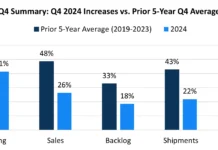by Nicole Mitchell, editor, Plastics Business
From topics such as bilingual training systems to what to do when an applicant ghosts, these are five of the common human resources challenges that companies face in the plastics industry.
Job Applicant “Ghosting”
The Great Resignation begin in 2021, with record numbers of people leaving their jobs when the COVID-19 pandemic hit. What began as mass retirement shifted as workers evaluated work/life balance, commutes, job satisfaction, career paths and more. The trend continues, according to the US Department of Labor, which reported that 4.5 million people quit their jobs in March 2022. In fact, almost half of employees are looking for a new job or plan to soon, according to a survey conducted by Willis Towers Watson, insurance brokerage and advisory company located in London, UK. Complicating the employment situation is the fact that US unemployment rate fell to 3.5% in April, with the number of people collecting ongoing unemployment benefits at its lowest since 1970. And, with durable goods orders still on the rise, manufacturers are struggling to find these seemingly nonexistent employee prospects.
Audra Kimbel is the human resource manager for PolyFlex Products, Inc., a manufacturer of material handling packaging solutions headquartered in Farmington Hills, Michigan, with additional locations in Michigan, Tennessee and Mexico. The PolyFlex website provides detailed information about job openings, pay rates and generous company benefits. In addition, the human resources team posts ads in a variety of locations to fill permanent employment openings while also working with temporary staffing agencies. Still, they struggle to fill open positions, and “ghosting” takes an exhausting toll.
“We write ads and we get creative in what we’re putting in those ads,” Kimbel explained. “We’ll get anywhere from zero to 100 people applying, and then we’ll read through the applications and send them off to the hiring manager in the department where their skills might fit. Then we go through the process of setting up an interview, calling, texting and emailing to confirm that they’re coming… and then we wait… and they don’t come.”
“Ghosting” is the term – first used in dating situations – for when one person in a relationship ends all communication without explanation. Unfortunately, ghosting has become common in employment scenarios far beyond not showing for scheduled interviews. “We have people who come in, go through the interviewing and onboarding process, accept an offer that we have made, agree to a start date and then don’t show up for their first day,” said Kimbel. “We end up having to report that to the unemployment commission.”
The frustrations can continue when using temporary staffing agencies. PolyFlex relies on five different staffing agencies in Michigan to fill its open positions. “From one agency, we’ll have eight temps who are assigned to us, but only two show up,” said Kimbel. “From another agency, four are assigned and all four come in – but two go to break and don’t come back. Then we find that these same people are being terminated from one agency because of their behavior, jumping to another agency and starting the process all over again.”
The repercussions of this constantly evolving temporary workforce are felt throughout the facility. “The struggle for our employees working through these situations,” said Kimbel, “is that they’re training people – taking time and showing them how to work within the company – and then these people don’t return. Then our employees feel defeated, and we have to reassure them that it isn’t them. They did nothing to cause this behavior.”
In addition to getting creative when writing job advertisements, expanding permanent employee benefits and working through a variety of staffing agencies, Kimbel also did a test case sample in 2021. “We increased the rate for temporaries from $15 an hour to $16.50 to see if we could get people in the door,” she said. “It was slow at first, but we started getting people in who not only stayed, but also referred others to us. We finally were able to stabilize our shifts.”
Other strategies shared by plastics industry companies include a return to the “old school” ways of hiring – meaning, walk-in applications and immediate interviews are the only options for those interested in joining a company. Similarly, there are companies that offer interviews on certain days only, cutting down on the time that is wasted if applicants were to ghost.
Employee Disengagement
As many human resources employees know, it is common for employees to seem disengaged in the work that they create. In fact, 53% of employees don’t feel attached to their company’s vision or goals, according to Revere Plastics Systems, LLC, Novi, Michigan. More importantly, 13% of employees are actively disengaged. This means that they can be hostile toward other employees and voice their dislike about working there – overall bringing workplace morale to a low. So, how do companies dealing with a high disengagement rate improve that?
Kristi Stuetzer, vice president of human resources at Revere, recommends that human resources departments automate the transactional functions of the job – such as employee updating, reviewing and processing paperwork; creating, maintaining, processing, referencing and storing forms and files and screening applicants for hire – and invest more time in activities as a business partner and building relationships with the entire workforce. By switching to an automated system for transactional tasks, Revere was able to spend more time sharing knowledge across teams, coordinating team building events, conducting surveys, deploying a meaningful onboarding program and more.
Overall, creating a workforce that is engaged means creating an empowered work environment. Focusing on operational excellence, talent development, succession planning, relationship building and recruiting is an important way of doing so. “We’re able to ensure that our organization is fully staffed at all times for our high turnover roles and that our HR Team is a trusted go-to resource for our team members,” Stuetzer said.
Attendance Policies
Good attendance matters, but in a low-unemployment market and with many employees dealing with challenging personal life situations, flexibility can be key for employee retention.
OMG Tooling Inc., Oklahoma City, Oklahoma, noted that the company stays away from a typical attendance point system. A point system is a way of disciplining employees after a certain number of points have been accumulated for late arrivals or absences. Too many points acquired by one employee can end in termination. “Our attendance and work schedule approach are focused on flexibility, keeping in mind of family’s dynamics and challenges,” Kris Ryan, owner and CFO, said. “OMG implemented a four-day work week (Monday through Thursday), allowing for three-day weekends. Both Vacation and Sick Pay can be used for absences. Employees also have up to an additional 104 hours of missed time during their anniversary period. This approach allows employees the flexibility to manage their time as needed without the worry of repercussion or termination. When a paid holiday falls on Friday through Sunday, OMG observes the holiday either Thursday or Monday. With our three-day weekends and Holiday Benefit, employees can enjoy 10 days off only utilizing two days of Vacation.”
At PolyFlex, the company has been observing flexibility with its attendance policy. In the office areas (Engineering, Customer Service, Accounting, etc), the company offers flexible hours and some work-from-home availability, depending on the needs of that area. “In the plant, it’s more difficult when you’re working with different shifts,” Kimbel explained, “because of our high press demand, it requires specific manning to maintain certain cycle times that need to be achieved in order to maximize run time. But we also have employees who have been working through struggles with school schedules, so we’ve adjusted the start times for our afternoon shifts for some employees. We have some employees stay longer to cover the presses for the people who are coming in for an adjusted shift. It does get a little crazy.”
Kimbel also said the company has relaxed its policies on verbal warnings. “We are making sure we are indicating notes on timecards if someone is late without calling or if they are habitually late,” she said. “We have it documented so they’re aware and we’re aware, but we’re not moving forward with disciplinary actions at this time. We’re understanding what they’re going through in their home life. They’re important to us.”
Performance reviews
Performance reviews help hold employees accountable for the work that does (or does not) get done. They also provide valuable feedback, for both the employee and the company, that can improve workplace culture and set both parties up for future success.
“We started working on a new performance review process in 2020,” said Kimbel. “We had some people with the ability to work from home and others, like those on our manufacturing floors, who cannot. That made it difficult when the old review process relied on paper forms that people sat down and filled out by hand.” Kimbel and her team reviewed documentation from industry surveys and best practices from books to put together review a new set of review questions, taking into consideration that the review was evaluating an individual, rather than a position. Then, the form was created electronically, with formulas established so the reviewer could place an “x” in a box and the form automatically would total the score for an employee’s performance. The new process also evaluated employees who had potential to grow into a lead or supervisor role by adding sections that could grade an employee with both an employee review score and a supervisor score.
PolyFlex keeps the last score from each employee review on file so it can be reviewed and utilized in setting new goals. Then, the company took another step.
“We decided to do an employee input form,” Kimbel explained. “We want to know what the employees have to say. Are they happy in their positions? Do they have the tools and equipment they need to perform their jobs? Do they feel safe in their environment? Do they feel our leaders represent our organization and follow our values?”
When an employee is moved into a new position (for instance, from a floor role into a supervisory position) or when a new employee is hired, the employee input form is given to them prior to their 90-day review. “When they sit down with their supervisor, then it opens their conversation up to one-on-one communication so the supervisor has better insight into what the employee is feeling,” she said. These 90-day reviews have been beneficial that the company. It now is considering the elimination of its traditional annual review process to implement reviews in shorter increments – say 90 days, or more frequently – for all team members.
On January 1 of this year, Kimbel added yet another layer of data collection to help her team understand what PolyFlex employees were feeling. “In the employee input form, we have sections where they can circle A – agree, N – neutral or D – disagree for a list of questions,” she said. “We started to track the neutral and disagree answers, creating a rolling set of data that showed employee feelings. We rolled it out to the management team in March, and it was received very well. It’s great data!” The next step is for Kimbel to put the data in graph form so the management team can understand where they need to focus and then see how the data is affected as new processes are rolled out.
Non-English-Speaking Employees
Many manufacturing companies are employing an increasingly diverse workforce. Communication about company policies, safety and job training can be difficult when English is not the primary language for a portion of the workforce.
“We have employees who speak Spanish, Vietnamese, Arabic, Indian – several employees in the office and on the plant floors who are bilingual,” said Kimbel. “We have an afternoon shift staffed mostly with people who do not speak English. They have a phone they can speak into that translates into English, and there is one person on that shift who translates for the rest of the team.”
PolyFlex also has a facility in Mexico, and an employee there has translated documents for the company. “A supervisor on day shift suggested translating brochures on our safety orientation, sexual harassment and workplace violence policies into Spanish,” Kimbel said, “so we have those available.” The company also has created brochures in both English and Spanish that talk about the company and its employment benefits. These are given to temporary employees as a way of encouraging a shift to permanent employment.
Paulson Training Programs, Inc., Chester, Connecticut, also has recognized the challenges in training employees who speak English as a second language. It recently released a Spanish version of its online SkillBuilder program, an injection molding machine simulation learning tool. Paulson’s online lab lessons simulate an in-person molding environment, giving users the ability to practice injection molding concepts in a worry-free environment while increasing molding knowledge.
In addition to company documents and training programs, some benefit providers are expanding their offerings to include other communication options. “One of our benefit programs is through HoneyBee Financial Benefits,” Kimbel said, “and the financial coaches available through that service have a variety of languages they speak – so even our benefit providers are seeing the need for these things.”
“We’re trying to do everything we can,” Kimbel added. “We want people to like where they work, what they do and the people they work with, so we’re doing everything we can to make that happen.”





